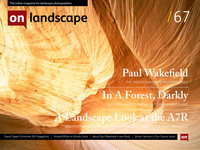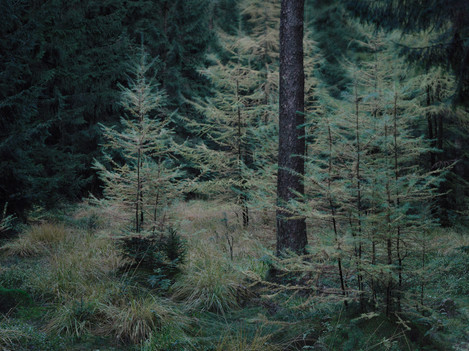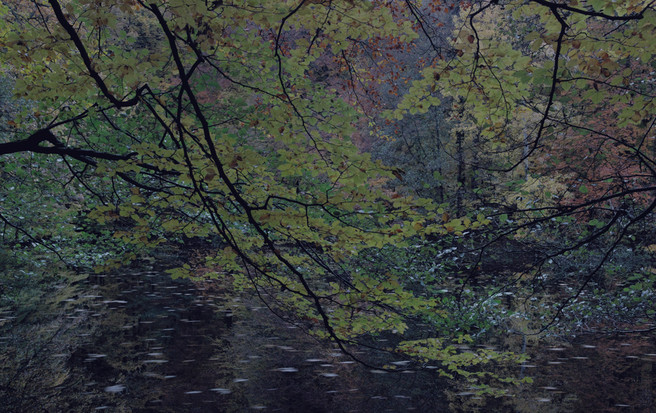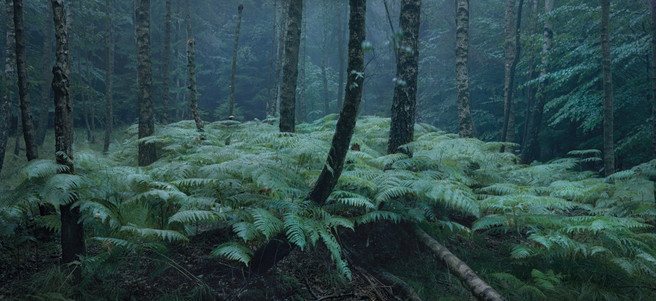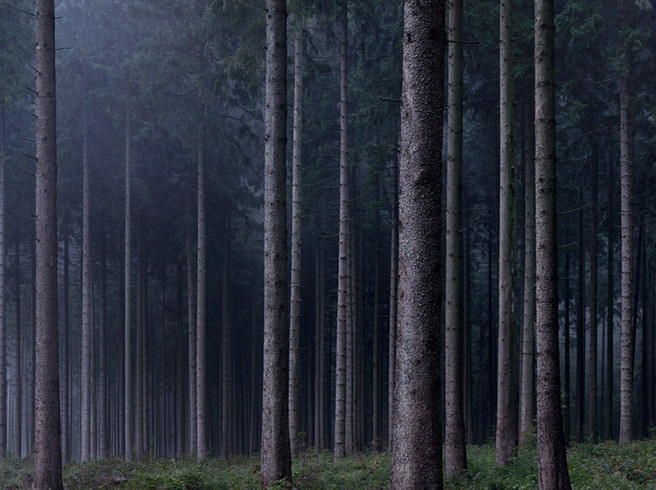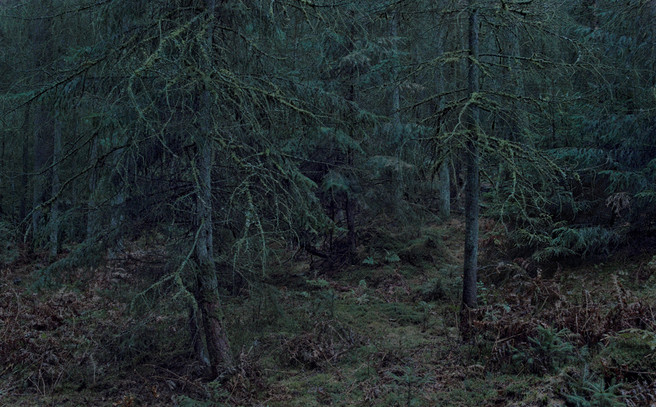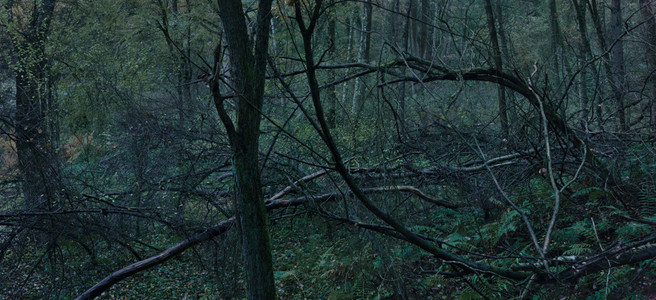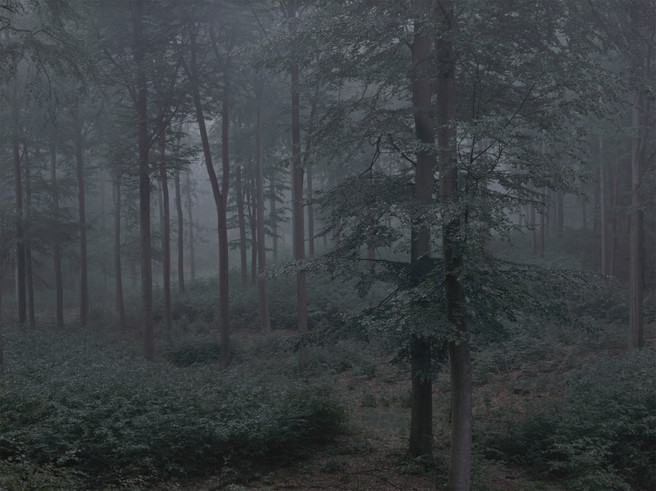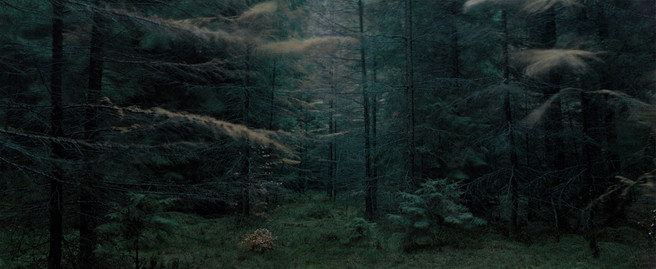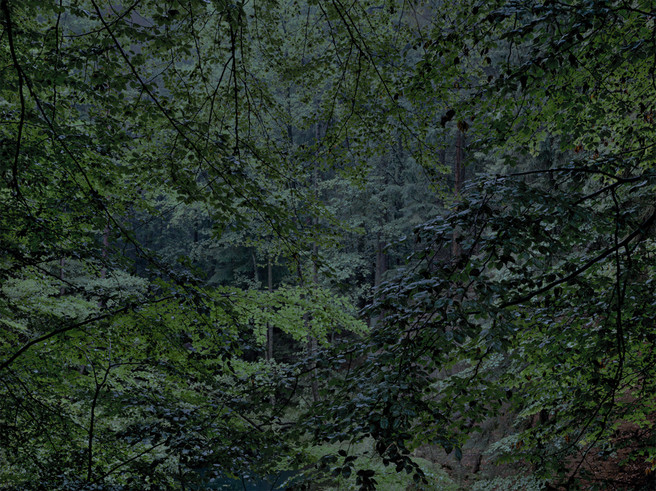Michael's fascinating images of forest taken in near darkness warrant contemplative viewing to appreciate their beauty

Tim Parkin
Amateur Photographer who plays with big cameras and film when in between digital photographs.
How did you get into photography originally?
Well, I’m a self taught photographer. I first saw photography when I was seventeen and when I was eighteen I decided to become a photographer and I said “OK, a career as a photographer takes 8-10 years, are you willing to go for that?” and I said yes. So it took me 10 years to get into Stern and Die Zeit magazine.
This is photo-journalism?
Yes, I was into journalistic photography for twenty five to thirty years so I mainly did Stern, Geo, Art magazine - portraits, features, technology, etc. Like stories about how Steinway pianos are made from a piece of wood to a royal festival hall. So you work on a project like that for four weeks but also covering news events like earthquakes. Stern and Geo were my main clients though.
And after a while the money in that sort of work went down but it changed significantly in the mid 1990s and then from 2000 onwards I was mainly photographing annual reports.
Was this portraiture?
Well, I was photographing for Management magazine so I did do a lot of portraits of executives but I was doing annual reports for EADS who owns Airbus and has major contracts with the European Space Agency but for the complete annual report I would shoot in the factories and photograph executives. So I was basically a combination of reportage and portraiture.
But in 2008 this work just stopped dead with the economic crash and suddenly from being full employed and making a lot of money it was zero bookings. So I had to think about what I could possibly do. Sitting looking at the phone wasn’t helping so I thought I’d get away from the office and shoot some landscapes. I started shooting and it wasn’t really doing anything for me - it was fun but that was all. And then I went out into the woods and I was overwhelmed with the complexity but at a certain point I was shooting around twilight and I thought “That’s interesting!”. Something happened that tweaked my interest.
So this was in the morning?
Oh no, these were at dusk. I don’t do very well in the mornings and the problem is you need to know exactly where you go if you shoot in the morning. You need to find your photograph in the evening and set up your positions etc. You can’t scout for photographs in the morning, it doesn’t work. Especially when you have such a short window to work in.
Anyway, I started photographing the woods at dusk and I followed that for two and a half years. I showed it to my gallerist who already had a show with me two years before about a series I shot in Los Angeles called “LA Drive By” - I don’t know if you’ve seen it - so that was a very different kind of photography, taken from the car - not looking through the camera, black and white Polapan 35mm. Scanned to 200Mb and printed large.
So he looked at the images and said, “Sure I’ll show it. Whenever you have a book let me know”. So I was lucky and got in with Hatje Cantz and they said “sure we’ll do it” too. We had an agreement that I would buy 300 books for a fair price and he would produce the book. In the end we produced nearly 1800 copies which are nearly sold out. So on the back of that I have had five shows and the images are printed at between 60x80cm up to 2m x 1.5m.
Editors note- the book 'Wald' (Forest) can be found on Amazon
That’s a reasonable size for a print!
Yes! We’ve sold them pretty well. Last year I couldn’t live off the sales but this year is looking like I can. So I was pretty lucky. It’s a different life as an ‘artist’ than a professional photographer though.
Had you done much landscape photography before this project?
I have done landscape for Geo and Stern when I did stories. For instance, I did two stories about Portugal - one for Green Geo and one for Geo special about Portugal and within these stories, I did landscape work. But I never really gave myself fully to it no.
But the situation was that when I thought about what can do personally and where can I open something artistically new I thought I need a field where I feel safe and to be out in the landscape or wilderness is where I feel safe. Because when I do a job I very clearly know what I have to do. If it’s a double spread I know where the fold is. Sometimes I walk into a job and I tell them they have to reorganise the place to fit the fold in. So I’m used to being quite demanding and when you work for Stern and Geo you are ‘somebody’ and can walk into a place you can dictate to a point. When you’re out in the landscape though that way doesn’t work.
I don’t know what is going to happen and that is what I have to embrace. Not knowing is the most important and most critical part of the photography. Frankly, sometimes I’m just scared to death because I just don’t know - nobody likes it! Nobody likes to be in the middle of a “don’t know” situation. But I need to do that if I have images that surprise myself.
I do catch myself repeating myself on occasion and I have to berate myself. I have a stack of reproductions of my images that I carry around with me so I know what I’ve done in the past. I haven’t looked at them for a long time but they’re there.
The other aspect is that my photography is about this fleeting moment that you just can’t quite catch but always want to grab ahold of. So I’m never really sure about things.
So you don’t set yourself a brief as a photographer when you’re out working on these projects?
No, the only brief I set myself is geographic. I’ll work in an area and then give myself to it.
The other day I was in a situation with a colleague of mine who is also a landscape photographer and I said to him “Nothing is happening. I don’t see anything. I’m stuck” and he said “Well Michael, just look deeper” and it sounds trite but it really works that was.
I was out photographing reeds the other day and I was walking around for kilometres and I just didn’t get it. I couldn’t see anything and as I was driving around the corner I saw another similar area but when I got out the image appeared and so I visited at dawn and dusk and got my picture.
How much of a window of time have you got to get the picture you want? I know in the Wald book it looked like you went from early dusk to almost dark but how much time have you got to capture your work?
It depends on the weather. Right now we have a lot of mist and it stayed around all day and because of that and the Autumnal light with the low sun you have quite a large window to play with.
On a ‘normal’ weather day it’s quite different. Because I have to wait for the light to get a photograph, I can’t photograph too dark because I have a limit of 10 seconds on my camera and I’m shooting at f/11 to get my photograph it means that I probably have about 10 minutes in which to capture the picture before it gets too light.
These days I find my locations in the evening and then mark the camera with paper knots on the trees and crosses where my tripod has to go and then I come back in the morning. In the morning I have to admit that I do think dawn is more interesting than dusk right now. You have more humidity out there and you have reflections from the wet leaves. When leaves are dry they are quite dull but in the morning they are like glossy paper - a very different look.
I get a very small window where I can probably take two or three photographs that are beautiful. Occasionally it can be magical and I probably have two or three images that have captured that beautiful, exciting look.
Most of the time I don’t get it though, I don’t hit the right moment or I go the safe way and take no risks. But it’s the risks that make something new and exciting.
When and how did you decide to take pictures that are so dark? Did this come about through experimentation?
Well yeah, it was experimentation but it was my reaction when seeing the images. I gave my mother, who is pretty old and in a nursing home, a big print for her wall and one day she was looking at it and said “Michael, is that how it looks inside of you!?” I like that.
In Germany the forest has cultural significance, there is an art history of people representing the forest. Romantic painters like Caspar David Friedrich played a big part in the definition of the Sublime - fear and fascination at the same time.
Do you think this fascination with the forest in German culture played a role in your success? There is definitely something about forests but they always know to leave the forests when it gets dark. A lot of people say to me “Aren’t you scared when you’re out there?”. So there is definitely an aspect of that and some people do find my pictures scary. But what I was looking for in the woods is some sort of zero point. A point or idea that you can’t nail down. People often say “I know where such and such picture is taken - it must be here or there” but I won’t tell them because it doesn’t matter. You can go where you like in the German forest and you’ll find what I photograph. So for me, I especially choose the forest because it felt like a safe place for me.
Are the forests in the book local to you or did you end up travelling to work?
Well some of them, probably about 50%, are done nearby where I live so I could wait for the right weather and then rush out to get the photograph. One photograph I really wanted to capture was a really heavy downpour, these downpours that only happen for a minute. It took me about five or six trips to get this and I finally captured the moment - I couldn’t have done that if I had to travel a long way.
When you went to the publishers and you showed them the photographs, did they have any concerns that they would be able to print it to your satisfaction?
No. I have a woman who works for me that creates the hi-res prints. I took these to the printer so I had the prints with me when we were on press for the final run and the printers said “let’s work with your prints, they’re much better than our proofs.
It took me about twelve hours on press to get the colours signed off though.
A friend of mine has had the book for about a year and he just went to see a show of mine and he emailed me to say “Wow! That is a tremendous difference - now I understand what you did”. So when you have it in very large print form you can really see the detail.
So are the prints the same lightness as your book?
Yes, they are about the same and the funny thing is that a colleague of mine Peter Bialobrzeski (http://www.bialobrzeski.de/), he said “You will see that your book will become of the master print in the end”. And it’s true - now when I do the mastering my book is the reference.
It’s too easy for me to say “Now I’m in a different mood so I’ll print it differently” but it’s the book you follow.
What was the reaction when you bought the book out? I notice that there is a Simon Schama quote on the back - did that take some getting?
That is from "Landscape" and it took me three months to get the quote:-
"Landscapes are culture before they are nature, constructs of the imagination projected onto wood and water and rock"
(Editors note: available from Amazon)
I thought you were going to say it took you three months to read the book - which wouldn’t surprise me.
Oh yes - it took me ages to get through it. But to get the permissions for the quote it took quite a long time. A lot of people don’t seem to understand it though
But the reaction to the book was great. I was really pleased and this is why we sold so many books. The second show in Berlin which was in The Alfred Ehrhardt Foundation, sold like crazy and in two months we had more than six thousand people coming and looking at it. It was the most successful show they ever did. And they specialise in landscapes.
It’s interesting because the landscape is considered as one of the lowest art forms if you talk to painters and art historians. There is a colleague of mine who started as a painter and he was berated by his teachers for wanting to paint landscape and then when he decided to do landscape photography instead everybody said it was a suicidal move. But there is something about that landscape that people connect with viscerally.
With my images, it is quite clear why people connect with it. It is the stillness and that is one of my main points of focus. I don’t want to make pictures where I tell people what to see. I work at dawn and dusk because you have a different lighting situation where the images open up further. This is why I reduce colour by sometimes forty percent out of my images because the sensor is so sweet, so full of colour that it’s sticky. So for instance in the show in Berlin, I met people who said “Oh I’m the third time here” and people just used to sit and watch the pictures for hours.
This is why people buy these images because they are quiet. For instance, one doctor in East Germany bought an image and after half a year he sent me an email which said “The other day I came down to my living room and it was still dark with just a little light in the room and I didn't have the lights on and suddenly your image started to glow”. He realised that this image changes with the lights.
We do see differently in the dark and I think that is something of what you’ve captured.
What I still haven’t managed is the focus because when you are deep into dawn or dusk two things are happening, to my eyes at least, I stop seeing colour - perhaps a little but very desaturated - but also the focus switches. I can’t focus properly and it’s like my eyes are having difficulty focusing. I can’t capture this though - perhaps I need to go back to film and buy an old pictorial lens. And that’s interesting because photographers then were trying to create images that looked like paintings and if I could paint I would.
How did the idea for the follow up project - the Wetland project - start?
The idea started after I published the book and I was looking again for something new. I was driving to my publisher in Stuttgart in the corner of my eye I saw this landscape and had that buzz again. So I went back and tried to capture things. But I have a problem in that I’m not a walking person - I run and exercise but I don’t like hiking. For the woods project, I had permissions to drive through all of the forest routes so whenever there was a sign that said “Don’t drive here” I could go past.
When I looked at the wetlands I called a friend of mine who was a mosquito hunter for forty years on the Rhine.
A scientist?
He did some scientific work but he was mostly trying to reduce the levels of mosquitoes for disease control. So he showed me around and people started to realise I was with this company that had done a lot of good.
So once I realised that this is a project that was working for me I talked to the minister of agriculture for the states and then I wanted to drive on the dikes and it’s very hard to get the key for all of the barriers. In the end, though I’ve ended up with this huge keyring with permission. So now all I need is the time.
So this is the project that you’re currently working on? How long have you spent on it?
Last year I spent about three weeks and this year I’ve spent eight or nine weeks. I may finish the project this year but I might come back once the river is frozen and do a little more. But I’m starting a new project as well at the Alpe Maritime on Rocks. It’s an area close to Nice. It’s about 1500m across. Again it came about while I was talking to friends of mine who walk the mountains - I asked if they had any ideas about where you might find plain rock, etc. and I talked to professionals in Germany. But the answer was always “You have to hike for six hours!” because there are no roads. But I was told about an area where every valley had roads so I ended up at the Alpe Maritime for three weeks living in a little hut on my own with no electricity and outside toilet etc. But I haven’t looked at the images so far.
When will you look at those then?
I will look at them once the Wetlands is complete in February.
Is the Wetlands book coming out then?
No - no publisher yet as they haven’t seen the work. I probably won’t get Hatje Cantz because they are now into making a profit so they’ve reduced their range and want to print volume. And mine are always going to be small prints.
I called Michael back a week later after he had sent me a few images and we talked about a couple of them, the workflow of capture and post processing etc.
Can we talk a little about the cover image for the book - why this particular image?
Well, the cover photograph for the book is - I choose it because it had a certain darkness and a certain depth to it. I thought it was pretty mystical and it left a lot of questions open, it was that “bang” photograph like maybe 2016 which is the best seller and everybody wants it. But I like the cover very much. I also chose the cover because I wanted it to flip onto the other side of the book. There were not many shot in this format as a triptych so I could wrap it because I wanted to connect it with the sentence on the back of the book.
For a photograph like the cover one - how long after sunset or before dawn was this taken
This particular one was taken right after sunset but it’s a day where it was pouring like hell and in that image, it was pouring like hell so when you work at this time of the day the time window you have is really tight. It is a very early one and was shot in Autumn 2009 so this is one of the first ones that was really the inspiration, where I thought “yes, this is it”. I still like it a lot but it’s funny - I haven’t sold a single print of it whereas nearly all of the others have sold pretty well.
Do you think it’s because it has more of an eeriness to it
Yes, it is pretty eery. I like that eeriness but it’s possibly one of the more extreme ones where people say “I get scared”
I think when people are looking at photographs of trees, even if they don’t do it consciously they anthropomorphize the trees into characters so when they look at these two you can see a couple of ‘shady characters’ looking back at you.
It’s interesting that you say it was taken in the rain as we can’t see that but we can see what looks like a mist because of it.
Well, the point is that I don’t want to shoot weather, I don’t want to show weather or talk about the weather at all in my images. But on the other hand, I really used weather a lot to create the images. I would say that in at least 60% of my images it is raining. Some of the images it’s pouring. For the cover image it was really pouring - it was one of those days where people just don’t want to be out. It was maybe 6 or 7 degrees and just desolate out there. But this is the weather I love most because then I know that it’s all mine.
I would almost say that you don’t use the light as well as the weather. There is an absence of overlighting in nearly all of your pictures.
I think I may have said previously that I’m looking for a “zero point in the woods”. A realm where you can’t connect with your memory - I don’t want people to say “Ah! This is like ….” - I want people to connect with the images but not with a conscious part of your mind. This is why I never have sunlit days, there isn’t one image I’ve shot where there is any sunlight in it and this is why I just use the twilight because it is a different realm I’m shooting in. I don’t want to show a certain area in nature; I’m not the sort of landscape photographer that says “Look at this - this is what I’ve found, this is what I saw”. Instead, I try to use landscapes to express what I feel more. So landscape and weather are just things that help me express myself.
I think this is why a lot of people came to the Berlin show three or four times. Because something different happened to them when they sat there and looked at these images and let them do their work. It’s very different when you see them in the show - a tremendous difference.
Do you think that the scale in which you present images is an integral part of people’s appreciation of them?
I have these discussions with my gallerists and I just talked to one in Frankfurt the other day about formats for the Wetlands exhibition. I asked him what he thought and he said “ Michael, please have smaller images!”. For the woods exhibition thought the mid-size format which is 130cm by 100cm was the format I had from the very beginning on what I shot. And when I saw the images in the large size like 200cm by 150cm I just loved them. But they are so, so costly. They are expensive when I’ve sold them and they are expensive to just frame them. Just the framing is 2,500 Euros.
How are they framed?
It’s Dibond in a wooden frame with museum glass and the museum glass for the large format is a special type, Mirogard glass from Schott.
You don’t use Acrylic for your large pictures then?
No, I hate it - I don’t like it at all. Truview - yes I know it and don’t use it.
How about picture 3176 of the almost random arrangement of branches
Oh yeah! One of my favourites.
But I think a lot of people will take a look at that and say “But it’s not composed!” and yes there is a lot of considered placement I think.
Normally when you look at the images people choose they are very composed. But I like this picture a lot because it is that wild and it’s one of the images that I spent a lot of time one. But every picture is composed, you have to bring order from the chaos of the woods. When you do nature photography or landscape photography you have to bring order into wherever you are because it is chaos and you have to present it to people.
But there is a level of order and chaos within composition and you can decide how to balance those?
Some of the images I worked a long time on, so I went and revisited on multiple occasions and fiddled with them and I like to make myself really familiar with, almost at home with a location before I create an image. This was a new forest I went too and after 10 minutes I went somewhere and hey, there was the picture. I made my little knot in the branches and put my cross on the floor to mark where the picture was and then returned at dusk and it was perfect. It was one of the easiest images that I’ve done in the woods - everything was presented to me. I really like it a lot and I think it has a wonderful order and it was in all my shows - nobody has bought it so far though.
I’ve obviously got a bit of a perverse choice in images so far then
Well, this is the image that was hanging a long time in my studio so it’s one of my favourites. Some of my other images are very easy to look at, for instance, 4912 is very classically composed but where I returned to the location multiple times. The first time I saw this location I was waiting for a strong rain and I shot around this area and then went to another area and suddenly a huge downpour started and I realised that this is exactly what I needed for the original location and I started to run through the woods with a tripod and backpack and wellington boots - I always end up running - but sure enough, I was too late and it was still raining but it wasn’t the downpour I wanted. I wanted a torrential downpour! They are very brief so it took me about four or five times.
Is this the picture you’ve mentioned previously about having to go back to repeatedly?
Yes, that’s right. What you think you see as fog in this picture is actually just huge amounts of rain. I have lots of different shots of this same location. On the last visit I set up the camera and right beside me was a cut of trunk of a tree - normally I have a sou'wester for my camera and one for myself but this time it didn’t look like it was going to rain and so I left it behind. So I sat down on the trunk and the instant I did so it poured down harder than I’ve ever experienced and I got so ****ing wet you would not believe it but it was the perfect rain for me!
Moving on to a different image, 0576 which is of windblown yellow branches in a deep forest. Can you tell us a little about that.
This is one of the rare images that aren’t still because it was a real storm. I was deep in the woods and normally wind doesn’t reach there and this is really thick wood. It was very difficult as I was standing on a little ladder. I always take a ladder to get a little three step ladder to get a little aerial perspective. It’s pouring like hell and so windy and the light has almost gone. This was a 20 second exposure so praying that I would have the right wind for the four shots - two left side shots and two right side shots and then the light was gone. 20 seconds is the longest exposure I can get with the medium format back and so I was really lucky to get this.
Out of interest - the pictures that you included in the book, how did you choose what aspect ratios to work with?
Well, that last image is an early one and is a bit wider. What I used to do with my Cambo was to shift 20mm either side and then I would flat stitch these together. But then I realised that these panoramic images are too long for me so I just shift 15mm instead.
[ed - the wider ones are nearly 2.5:1 but you’re using just a bit wider than 2:1 instead now.. and your standard images or 4:3]
How do you compose when you are in the forest? Do you use a viewing card or just use your eye?
I just look at the situation and I know what I’m going to see, whether it was panoramic or not etc. In the new Wetlands project there are no more panoramic images; They didn’t seem to work. My camera format is 3:4 (36mm by 48mm)
What camera are you currently using?
I have a Cambo with a Leaf digital back. But it’s all the same technology and at a certain point they all suck because you can’t have longer exposures than twelve seconds and even the newest sensors that have longer exposures make you wait for the length of your photograph (to reduce the noise)
I think the idea is that you buy two of them!
I think I’m happy with the Leaf camera I have. I have the Leaf where you can switch the sensor from horizontal to vertical without tilting the camera and I can stitch shots very easily. So I can do two exposures so my 75mm is a 50mm and my 120mm is a 90mm so I have four focal length combinations with two physical lenses. It helps when you’re carrying things around. It helps every more with the cost as the lenses are costing £3,000 and more.
So in terms of the editing process for your images, you have mentioned that you have started working on a Rock project and taken a lot of photographs already but haven’t looked at them and won’t for a while yet - what is your workflow once you do?
That is a difficult question. It’s hard for me to do the editing. It scares me. What I try to do when I edit is first to run them through Lightroom, work a little on them with simple grads and global adjustments and then develop them to TIFF files in full resolution and then I throw them into Media Pro. I’ve flagged or starred a few in Lightroom but they get edited closely in Media Pro. I know whether I like what I see or they need more editing, is it enough as a base to switch to Photoshop to look at the image deeply. When I look at the image deeply I then print it. The only thing that counts for me is the print and what I see on the screen doesn’t really count - it doesn’t have any value as I always end up in print and if it doesn’t work as a print then it doesn’t get used.
So how many would you print out to assess?
I’ll show you - here’s a pile of prints for wetlands [Michael shows me a 5 inch thick stack of A4 inkjet prints]. So after I’ve processed these and worked out whether I need more work, etc I then print them as A3+.
So when you’ve done your rough work in Lightroom to bring the pictures to a good base layer, what work goes into them in Photoshop?
I always work on the colour because the sensor is like a jar full of sweets with all kinds of flavours and taste. It’s just too much. I then colour balance because the sensor doesn’t know what I want - I work with the grey picker in photoshop to find a base for the colour.
Do you make many local adjustments?
Yes. Some I don’t have to do a lot but like the image, we talked about with a lot of rain and you mentioned the light in the depths of the picture. I would work with that as I have to control where the eye goes and how the eye walks through the image, this is my job to set this - I can tell what the eye will do and where the eye will end up in a picture. Where your eye looks and doesn’t in an image is the whole thing about my images - to decide where the eye goes in a picture is everything. I can draw the eye to an area or flatten an area to tell the eye to ignore it. For instance, on the cover picture there is a very subtle path in the image that you can barely see but I really worked on that so that you don’t see it straight away but in the back of your mind you see it and your eye.
A final question - what is your favourite image from the book?
Well it changes
OK, when the book was first published what was the photo that you kept getting drawn back to? The one you were excited about seeing large.
Well, one of my favourites is 5476. It has so many levels, when you look at it it’s very untypical for woodland. That’s an image I shot on a very dark day and I revisited it very early in the morning and it’s the first shot I took. I kept going back trying to get it better but sometimes you need to say “enough!” you’ve got what you needed already.
- 0576
- 0299
- 0075
- 4912
- 3176
- 0095
- 2848
- 5476
Don't forget you can see more of Michael Lange's pictures at website www.michaellange.eu and his book Wald is available from Beyond Words.

